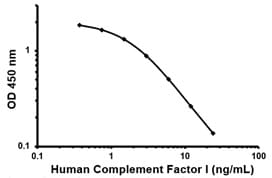Human Complement Factor I ELISA Kit (ab195460)
Key features and details
- Sensitivity: 0.3 µg/ml
- Range: 0.375 µg/ml - 24 µg/ml
- Sample type: Cell culture supernatant, Milk, Plasma, Saliva, Serum
- Detection method: Colorimetric
- Assay type: Competitive
- Reacts with: Human
Overview
-
Product name
Human Complement Factor I ELISA Kit -
Detection method
Colorimetric -
Precision
Intra-assay Sample n Mean SD CV% Overall 7.3% Inter-assay Sample n Mean SD CV% Overall 10.1% -
Sample type
Cell culture supernatant, Saliva, Milk, Serum, Plasma -
Assay type
Competitive -
Sensitivity
0.3 µg/ml -
Range
0.375 µg/ml - 24 µg/ml -
Recovery
98 %
-
Assay time
3h 00m -
Assay duration
Multiple steps standard assay -
Species reactivity
Reacts with: Human -
Product overview
Abcam’s Complement Factor I Human in vitro competitive ELISA (Enzyme-Linked Immunosorbent Assay) kit is designed for the quantitative measurement of Complement Factor I levels in plasma, serum, milk, saliva, and cell culture supernatant.
A Complement Factor I specific antibody has been precoated onto 96-well plates and blocked. Standards or test samples are added to the wells and subsequently biotinylated Complement Factor I is added and then followed by washing with wash buffer. Streptavidin-Peroxidase Conjugate is added and unbound conjugates are washed away with wash buffer. TMB is then used to visualize Streptavidin-Peroxidase enzymatic reaction. TMB is catalyzed by Streptavidin-Peroxidase to produce a blue color product that changes into yellow after adding acidic stop solution. The density of yellow coloration is inversely proportional to the amount of Complement Factor I captured in plate.
The entire kit may be stored at -20°C for long term storage before reconstitution - Avoid repeated freeze-thaw cycles.
-
Platform
Microplate
Properties
-
Storage instructions
Store at -20°C. Please refer to protocols. -
Components 1 x 96 tests 100X Streptavidin-Peroxidase Conjugate 1 x 80µl 10X Diluent M Concentrate 1 x 30ml 20X Wash Buffer Concentrate 1 x 30ml Biotinylated Complement Factor I (Lyophilised) 1 vial Chromogen Substrate 1 x 8ml Complement Factor I Microplate (12 x 8 well strips) 1 unit Complement Factor I Standard (Lyophilised) 1 vial Sealing Tapes 3 units Stop Solution 1 x 12ml -
Research areas
-
Function
Responsible for cleaving the alpha-chains of C4b and C3b in the presence of the cofactors C4-binding protein and factor H respectively. -
Tissue specificity
Plasma. -
Involvement in disease
Defects in CFI are a cause of susceptibility to hemolytic uremic syndrome atypical type 3 (AHUS3) [MIM:612923]. An atypical form of hemolytic uremic syndrome. It is a complex genetic disease characterized by microangiopathic hemolytic anemia, thrombocytopenia, renal failure and absence of episodes of enterocolitis and diarrhea. In contrast to typical hemolytic uremic syndrome, atypical forms have a poorer prognosis, with higher death rates and frequent progression to end-stage renal disease. Note=Susceptibility to the development of atypical hemolytic uremic syndrome can be conferred by mutations in various components of or regulatory factors in the complement cascade system. Other genes may play a role in modifying the phenotype.
Defects in CFI are the cause of complement factor I deficiency (CFI deficiency) [MIM:610984]. CFI deficiency is an autosomal recessive condition associated with a propensity to pyogenic infections. -
Sequence similarities
Belongs to the peptidase S1 family.
Contains 1 Kazal-like domain.
Contains 2 LDL-receptor class A domains.
Contains 1 peptidase S1 domain.
Contains 1 SRCR domain. -
Cellular localization
Secreted > extracellular space. - Information by UniProt
-
Alternative names
- AHUS3
- ARMD13
- C3b INA
see all -
Database links
- Entrez Gene: 3426 Human
- Omim: 217030 Human
- SwissProt: P05156 Human
- Unigene: 312485 Human






